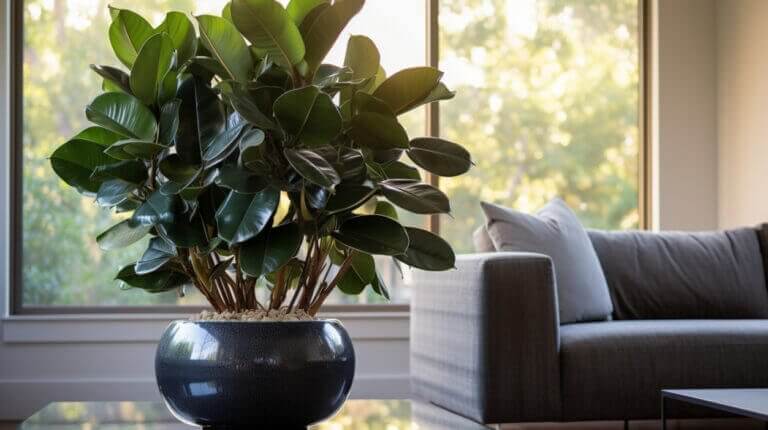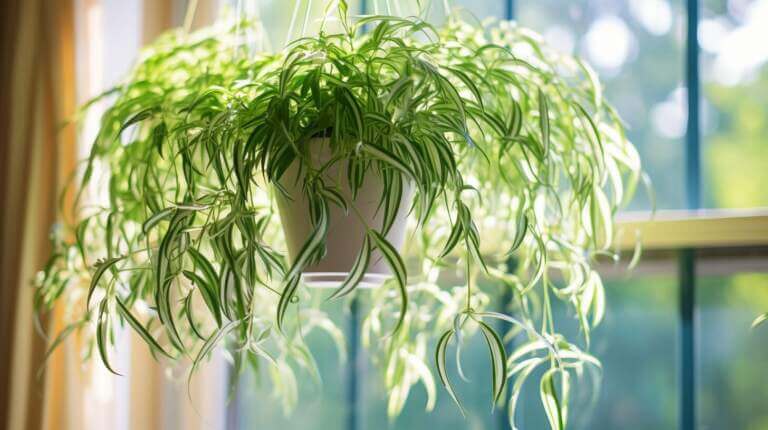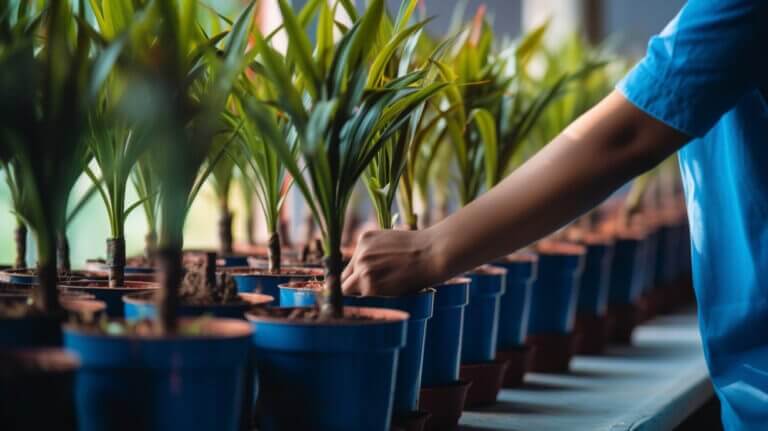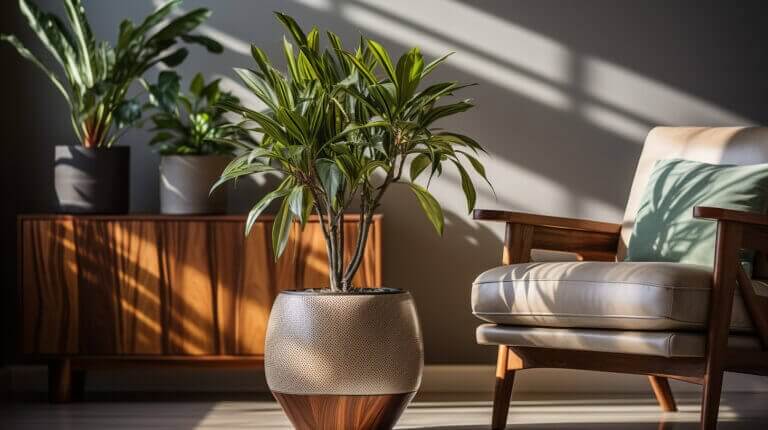How Much Water a Fiddle Leaf Fig Tree Needs
Fiddle leaf fig plants are beloved for their lush, tropical foliage and make a beautiful addition to any indoor space. However, caring for these unique plants can be a challenge, especially when it comes to watering. Finding the right balance between underwatering and overwatering is crucial for their health and longevity. In this guide, I will share valuable insights on how much water your fiddle leaf fig needs and provide essential watering tips to help you care for this stunning plant.
Key Takeaways:
- Fiddle leaf figs require careful and precise watering to thrive.
- Using a moisture meter can help you accurately determine when to water.
- Water thoroughly, allowing the soil to dry out before watering again.
- The frequency of watering depends on factors like plant size, container type, and environmental conditions.
- Filtered or distilled water is recommended for watering fiddle leaf figs.
Determining Fiddle Leaf Fig Watering Frequency
General rule of thumb for watering Fiddle Leaf Figs
When it comes to watering your Fiddle Leaf Fig houseplant, a general rule of thumb is to keep the soil evenly moist but not soggy. Overwatering can lead to root rot and other issues, while underwatering can cause the leaves to droop and eventually dry out.
To determine the watering frequency, it is essential to consider factors like the size of the pot, the type of soil used, and the environment where the plant is located. As a starting point, it is recommended to water your Fiddle Leaf Fig once a week. However, it is crucial to let the top inch of soil dry out between waterings to avoid overwatering.
To check if your plant needs water, you can gently stick your finger about an inch into the soil. If it feels dry, it’s time to water. If it still feels damp, you can wait a few more days before watering again.
Considerations for seasonal watering adjustments
As the seasons change, so do the watering needs of your Fiddle Leaf Fig indoor plant. During the warmer months, when the plant is actively growing, it may require more frequent watering. This is because the increased heat and light can cause the soil to dry out faster.
On the other hand, during the colder months, when the plant goes through a period of dormancy, it will require less water. The reduced light and lower temperatures slow down the plant’s growth, so the soil will take longer to dry out.
It is always important to observe your plant and adjust the watering frequency accordingly. Avoid sticking to a strict watering schedule and instead rely on the plant’s needs and the moisture level of the soil. Remember, it is better to underwater than to overwater, as Fiddle Leaf Figs are more tolerant of slight drought than excessive moisture.
Signs of Underwatering
Recognizing symptoms of insufficient watering
Underwatering can have detrimental effects on your Fiddle Leaf Fig. It is essential to recognize the signs of insufficient watering to address the issue promptly. Here are some common symptoms to look out for:
- Drooping Leaves: One of the first signs of underwatering is drooping leaves. They may appear limp and wilted, even after watering. This is the plant’s way of conserving water.
- Dry Soil: When the soil is too dry, it can pull away from the pot’s edges. You may notice cracks in the soil surface, and it may feel hard to the touch.
- Yellowing Leaves: As the lack of water prevents proper nutrient absorption, the leaves may turn yellow. The oldest leaves are usually affected first.
- Leaf Curling: Underwatered Fiddle Leaf Fig may exhibit leaf curling as they attempt to reduce the surface area to conserve water.
Importance of monitoring soil moisture levels
Monitoring the moisture levels of the soil is crucial to ensure your Fiddle Leaf Fig receives adequate hydration. Here’s why it is important:
- Prevents Overwatering: Overwatering is as harmful as underwatering. By regularly checking the soil moisture levels, you can avoid saturating the soil and causing root rot.
- Provides Timely Watering: Depending on environmental conditions, the soil moisture levels can fluctuate. By monitoring the soil, you can provide water when needed and prevent moisture stress.
- Promotes Healthy Growth: Consistently maintaining optimal moisture levels allows the Fiddle Leaf Fig to access the necessary nutrients, promoting healthy growth and preventing leaf drop.
Signs of Overwatering
Overwatering can be just as harmful to your Fiddle Leaf Fig as underwatering. It is important to recognize the signs of excess water and root rot to prevent damage to your plant. Here are some common symptoms to look out for:
Identifying signs of excess water and root rot
- Yellowing Leaves: When a Fiddle Leaf Fig is overwatered, the leaves may begin to turn yellow. This is caused by the roots being constantly saturated, preventing proper nutrient absorption.
- Root Rot: Overwatering can lead to root rot, which is a fungal infection that can be fatal to the plant. Signs of root rot include a foul smell coming from the soil, black or mushy roots, and overall wilting of the plant.
- Mold or Fungus: Excessive moisture creates a favorable environment for mold and fungus to grow. If you notice a white or green powdery substance on the leaves or soil, it could be a sign of overwatering.
- Wilting and Drooping Leaves: While it may seem counterintuitive, overwatered plants can exhibit wilting and drooping leaves. This is because the roots are unable to take up oxygen due to excess water, causing the plant to become stressed.
Preventing overwatering through proper drainage and soil type
To prevent overwatering and promote healthy growth in your Fiddle Leaf Fig, follow these tips:
- Use well-draining soil: Plant your Fiddle Leaf Fig in a well-draining soil mix that allows excess water to flow through easily. Avoid heavy, compacted soils that retain water.
- Choose the right pot: Select a pot with drainage holes to ensure excess water can escape. Additionally, using a pot with good airflow, such as a terracotta pot, can help prevent waterlogging.
- Water sparingly: Allow the top inch or two of the soil to dry out before watering your Fiddle Leaf Fig again. Stick your finger into the soil to gauge its moisture level.
- Monitor environmental factors: Consider factors such as humidity levels, temperature, and sunlight exposure when determining your watering schedule. These factors can influence how quickly the soil dries out.
- Avoid standing water: Never let your Fiddle Leaf Fig sit in standing water, as this can lead to root rot. Ensure that any excess water drains away completely.
Fiddle Leaf Fig Tree Watering Techniques
Proper watering methods to avoid leaf discoloration and root problems
To ensure the health and vitality of your beloved Fiddle Leaf Fig, it is crucial to master proper watering techniques. By understanding the specific watering needs of your plant and adopting the right approach, you can help prevent issues such as leaf discoloration and root problems.
Here are some essential watering tips:
- Water thoroughly: When watering your Fiddle Leaf Fig, make sure to water until you see it coming out of the drainage holes at the bottom of the pot. This ensures that the entire root ball is adequately saturated.
- Avoid overwatering: Overwatering is one of the most common mistakes that can lead to root rot. To prevent this, allow the top few inches of soil to dry out before watering again. Stick your finger into the soil about an inch or two deep to gauge its moisture level. If it feels dry, it’s time to water your plant.
- Use room temperature water: Use water at room temperature to avoid shocking the roots. Cold water can cause stress to the plant, while hot water can damage the roots.
- Consider the potting mix: Ensure that the potting mix used for your Fiddle Leaf Fig has good drainage. Well-draining soil allows excess water to escape, preventing waterlogged conditions that can harm the roots.
- Observe the leaves: The leaves of a healthy Fiddle Leaf Fig should be firm and upright. If you notice the leaves drooping or becoming discolored, it could be a sign of overwatering or underwatering. Adjust your watering accordingly.
Using the cup per two feet rule for measuring water
One popular method for measuring how much water your Fiddle Leaf Fig needs is the “cup per two feet” rule. This rule suggests using approximately one cup of water for every two feet of height. However, it’s essential to remember that every plant’s watering needs can vary due to factors like humidity, temperature, and sunlight exposure.
To effectively use this rule, follow these steps:
- Measure the height of your plant: Determine the height of your Fiddle Leaf Fig from the soil level to the tallest leaf.
- Calculate the amount of water needed: Divide the height by two. For example, if your plant is four feet tall, you would need approximately two cups of water.
- Water evenly around the base: Pour the calculated amount of water evenly around the base of the plant, allowing it to be absorbed by the roots.
Remember, this rule serves as a general guideline and should be adjusted based on your plant’s specific conditions. It’s always best to observe your plant’s response to watering and make adjustments as needed.
Fiddle Leaf Fig Plant Watering Schedule
Establishing a consistent watering routine
To ensure the health and well-being of your Fiddle Leaf Fig, it is crucial to establish a consistent watering routine. Consistency is key when it comes to watering your plant as it helps prevent both overwatering and underwatering.
Determine the watering frequency:
The frequency of watering your Fiddle Leaf Fig depends on various factors such as humidity, temperature, pot size, and soil moisture. A good starting point is to water your plant every 7-10 days. However, it is essential to monitor the soil moisture levels and adjust the watering schedule accordingly.
Check the soil moisture:
To determine the right time to water your Fiddle Leaf Fig, check the moisture level of the soil. Stick your finger about an inch or two deep into the soil. If it feels dry, it’s time to water. If it still feels slightly moist, wait a few more days before watering again.
Avoid overwatering:
Overwatering is one of the most common mistakes that Fiddle Leaf Fig owners make. It can lead to root rot and other health issues. To avoid overwatering, make sure the top few inches of soil have dried out before watering again. It’s better to underwater slightly than overwater.
Considering individual plant needs and behavior
While establishing a consistent watering routine is helpful, it’s also important to consider the individual needs and behavior of your Fiddle Leaf Fig. Each plant may have unique requirements based on its location, climate, pot size, and growth stage.
Observe your plant:
Take time to observe your Fiddle Leaf Fig and its response to watering. Look out for signs of underwatering such as droopy leaves, leaf discoloration, or dry and wrinkled leaves. On the other hand, signs of overwatering include yellowing leaves, root rot, or the presence of fungus gnats. Adjust your watering schedule based on these observations.
Humidity and temperature:
Humidity levels and temperature can significantly affect the watering needs of your Fiddle Leaf Fig. In drier climates or during the winter months when indoor heating reduces humidity, you may need to water more frequently. On the contrary, in humid environments, your plant may require less water.
Consider the pot size:
The size of the pot and the root system of your Fiddle Leaf Fig can also influence its watering needs. Smaller pots tend to dry out faster, requiring more frequent watering. Conversely, larger pots with a more extensive root system can hold more moisture and may require less frequent watering.
FAQ
How much water does a fiddle leaf fig plant need?
Fiddle leaf fig plants require careful and precise watering. It is best to water thoroughly and then allow the soil to dry out before watering again. The frequency of watering depends on factors such as the size of the plant, container, and environmental conditions.
How can I determine when to water my fiddle leaf fig plant?
Using a moisture meter can help accurately determine when to water your fiddle leaf fig plant. Soil moisture meters estimate the water content of soil and are cheap, easy to use, and readily available. Take readings at the same spot in the soil for consistency and water when the moisture meter reads just between moist and dry at the recommended depth.
What type of water should I use to water my fiddle leaf fig?
Using room temperature, filtered, or distilled water is recommended to avoid potential issues with tap water. If using tap water, let it sit out overnight to let the chlorine dissipate before watering your plant.
How much light does a fiddle leaf fig plant need?
Fiddle leaf figs require bright, indirect light to thrive. Place them next to a window facing east, south, or west to receive adequate light. They can also do well in rooms with vibrant ambient light.
How often should I water my fiddle leaf fig plant?
The timing and frequency of watering depend on several factors. Generally, water when the top 1-2 inches of soil is dry. In the summer, watering every 2-3 weeks may be sufficient, while in the winter, watering every 4-5 weeks may be appropriate. Adjust the frequency based on the specific needs of your plant and environmental conditions.
Can my fiddle leaf fig sit in standing water?
No, it is important to avoid letting your fiddle leaf fig sit in standing water as it can lead to root rot. Ensure that excess water drains out of the pot and remove any water that accumulates in the saucer or tray.






